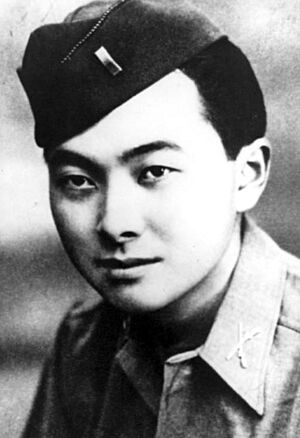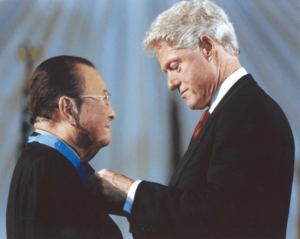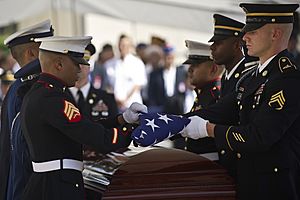Daniel Inouye facts for kids
Quick facts for kids
Daniel Inouye
|
|
|---|---|

Official portrait, 2009
|
|
| President pro tempore of the United States Senate | |
| In office June 28, 2010 – December 17, 2012 |
|
| Preceded by | Robert Byrd |
| Succeeded by | Patrick Leahy |
| United States Senator from Hawaii |
|
| In office January 3, 1963 – December 17, 2012 |
|
| Preceded by | Oren Long |
| Succeeded by | Brian Schatz |
| Member of the U.S. House of Representatives from Hawaii's at-large district |
|
| In office August 21, 1959 – January 3, 1963 |
|
| Preceded by | John Burns (Delegate) |
| Succeeded by | Thomas Gill |
| Personal details | |
| Born |
Daniel Ken Inouye
September 7, 1924 Honolulu, Territory of Hawaii |
| Died | December 17, 2012 (aged 88) Bethesda, Maryland, U.S. |
| Resting place | National Memorial Cemetery of the Pacific |
| Political party | Democratic |
| Spouses |
Margaret Shinobu Awamura
(m. 1948; died 2006) |
| Children | 1 |
| Education | University of Hawaii, Manoa (BA) George Washington University (JD) |
| Signature |  |
| Military service | |
| Allegiance | |
| Branch/service | |
| Years of service | 1943–1947 |
| Rank | |
| Unit | 442nd Regimental Combat Team |
| Battles/wars | World War II (WIA) |
| Awards | |
|
Other offices
2009–2012: Chair of the Senate Appropriations Committee
2007–2009: Chair of the Senate Commerce Committee 1987–1995, 2001–2003: Chair of the Senate Indian Affairs Committee 1977–1989: Secretary of the Senate Democratic Conference 1976–1979: Chair of the Senate Intelligence Committee |
|
Daniel Ken Inouye (ee-NOH-ay; September 7, 1924 – December 17, 2012) was an American lawyer and politician. He was a U.S. Senator for Hawaii from 1963 until his death in 2012. Before that, he was Hawaii's first U.S. Representative starting in 1959.
Inouye was a brave soldier in World War II. He earned the Medal of Honor, which is the highest military award in the United States. He was a member of the Democratic Party. He also served as the president pro tempore of the U.S. Senate from 2010 until he passed away. This made him third in line to become president.
Daniel Inouye was the highest-ranking Asian-American politician in U.S. history for a long time. He fought in World War II as part of the 442nd Infantry Regiment. He lost his right arm in battle and received many awards for his bravery. After the war, he became a lawyer.
He was elected to Hawaii's local government in 1953 and 1957. When Hawaii became a state in 1959, Inouye was elected as its first member of the U.S. House of Representatives. He was then elected to the U.S. Senate in 1962. He never lost an election in 58 years as a public official. He had a very big impact on Hawaii's politics.
Inouye was the first Japanese American to serve in both the U.S. House and the U.S. Senate. Many places and awards have been named after him to honor his service. For example, the Honolulu International Airport is now called Daniel K. Inouye International Airport.
Contents
Early Life in Hawaii (1924–1942)
Daniel Ken Inouye was born in Honolulu, Territory of Hawaii, on September 7, 1924. His father, Hyotaro Inouye, was a jeweler who came to Hawaii from Japan. His mother, Kame Inouye, was born in Hawaii to Japanese immigrant parents. Daniel was a Nisei, meaning second-generation Japanese-American, through his father. He was a Sansei, or third-generation, through his mother.
He grew up in a Chinese-American neighborhood in Honolulu. His parents taught him both American and Japanese customs. He went to public school and also a private Japanese language school. Inouye stopped attending the Japanese school in 1939 because he did not like the anti-American ideas taught there. He then focused on his studies at President William McKinley High School. He wanted to go to college and become a surgeon.
Inouye saw the attack on Pearl Harbor on December 7, 1941. This surprise attack by Japan brought the United States into World War II. Daniel was a volunteer first aid instructor for the Red Cross. He helped people who were hurt by anti-aircraft shells falling into the city. After the U.S. declared war on Japan, he worked as a medical aide. He went to school during the day and worked at the Red Cross at night.
He graduated from McKinley High School in 1942. Even though he wanted to join the military, he could not. The U.S. government had labeled all Japanese-Americans as "enemy aliens." This meant they could not volunteer or be drafted for military service. Inouye started college at the University of Hawaiʻi at Mānoa in September 1942. He studied to become a surgeon.
A War Hero (1943–1947)
In March 1943, President Franklin D. Roosevelt created the 442nd Regimental Combat Team. This was a special combat unit made up entirely of Nisei soldiers. Inouye joined the unit that same month. The 442nd had over 2,500 Nisei from Hawaii and 800 from the mainland. Inouye went with his unit to Camp Shelby in Mississippi for 10 months of training.
The 442nd went to Italy in May 1944. Inouye was promoted to sergeant within three months of fighting. The unit then moved to eastern France. They captured towns from the Germans. In late October, they rescued 211 soldiers known as the "Lost Battalion." Inouye was promoted to second lieutenant for his actions. He became the youngest officer in his regiment. During one battle, a bullet hit him in the chest. But two silver dollars in his shirt pocket stopped the bullet. He carried these coins for good luck.
His Brave Actions
On April 21, 1945, Inouye was badly wounded in Italy. He was leading an attack on a German stronghold. He was shot in the stomach but kept going. He and his unit destroyed two machine gun nests. As he crawled towards a third bunker, a German soldier shot a grenade at his right elbow. The grenade did not explode, but it cut off most of his arm.
Even with his arm severely injured, Inouye held the live grenade tightly. He used his left hand to pull the grenade from his injured right hand. Then, he threw it into the bunker, killing the German soldier. He kept moving forward, killing at least one more German. Inouye then fell unconscious. When he woke up, he told his worried men to go back to their positions. He said, "Nobody called off the war!" The ridge was captured that day without any more losses in his platoon. The war in Europe ended less than three weeks later.
Life After Injury
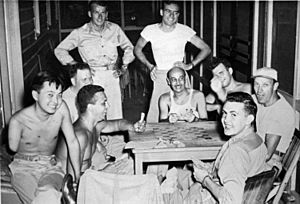
Inouye was sent back to the United States to recover. He spent 20 months in rehabilitation centers. While recovering, he met Bob Dole, who would also become a U.S. Senator and presidential candidate. They became good friends. Dole talked about going to law school and entering politics. This inspired Inouye, whose dream of becoming a surgeon was no longer possible.
Inouye was honorably discharged as a captain in May 1947. He had received the Bronze Star Medal, Distinguished Service Cross, and three Purple Hearts. Many believed he deserved the Medal of Honor. In 2000, President Bill Clinton finally presented him with the Medal of Honor. This was 55 years after his heroic actions.
Becoming a Politician
Inouye decided to study law to enter politics. He enrolled at the University of Hawaiʻi at Mānoa in 1947. He volunteered for the Democratic Party. He was encouraged by John A. Burns, who later became governor. Inouye married Margaret Awamura in 1948.
After graduating in 1950, Inouye went to George Washington University Law School in Washington D.C. He volunteered at the Democratic National Committee. He earned his law degree in two years. In 1952, he moved back to Hawaii. After passing the bar exam in 1953, he became an assistant public prosecutor.
In 1954, Inouye was elected to the Hawaii Territorial House of Representatives. This election was a big change, as Democrats gained control of the legislature. Inouye became the majority leader. He served two terms there. In 1957, he was elected to the Hawaii territorial senate. When Hawaii became a state in 1959, Inouye won a seat in the U.S. House of Representatives. He was Hawaii's first full member of Congress.
Serving in the United States Senate (1963–2012)
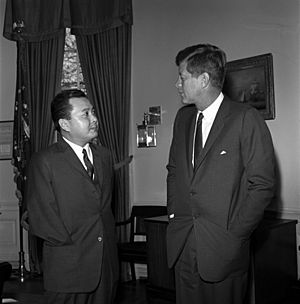
In 1962, Daniel Inouye was elected to the U.S. Senate. He took the place of Senator Oren E. Long. He was reelected eight times and usually won easily. He gained national attention for his work on the Senate Watergate Committee. This committee investigated a major political scandal in the 1970s.
Inouye also played a role in the Iran-Contra investigations in the 1980s. He chaired a special committee looking into this issue. He was known for being a strong supporter of Taiwan.
In 2009, Inouye became the leader of the powerful Senate Committee on Appropriations. This committee decides how the government spends money. After Senator Robert Byrd passed away in 2010, Inouye was elected President pro tempore. This made him the third person in line to become president.
Inouye ran for his ninth term in 2010 and won easily. He had planned to run for a tenth term in 2016, when he would have been 92 years old.
Important Laws and Decisions
In 1984, Senator Inouye helped create the National Museum of the American Indian Act. This led to the opening of the National Museum of the American Indian in 2004. This museum celebrates the history and culture of Native Americans.
In 1988, Inouye attended a ceremony where President Reagan signed a law. This law apologized for the internment of Japanese Americans during World War II. It also set up a fund to pay reparations to those who were held in the camps.
In 2002, Inouye was one of 23 senators who voted against using military force in Iraq. In 2005, he was part of a group of 14 senators who worked together. They found a way to avoid a major political fight over how judges are approved.
His Family Life
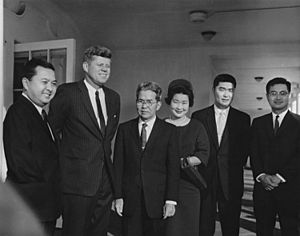
Daniel Inouye's first wife was Margaret "Maggie" Shinobu Awamura. They married on June 12, 1948. She passed away from cancer in 2006. In 2008, he married Irene Hirano. She was the president of the Japanese American National Museum. She later became the chair of The Ford Foundation. Irene Hirano Inouye passed away in 2020. Daniel Inouye had one son, Kenny, who became a guitarist in a band.
Special Awards and Tributes
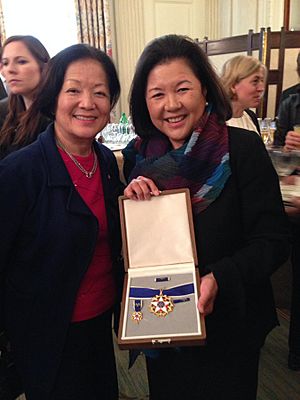
Daniel Inouye received many honors throughout his life and after his death.
- In 1993, he received the Grand Cross of the Philippine Legion of Honor.
- On June 21, 2000, he was given the Medal of Honor by President Bill Clinton.
- In 2000, the Emperor of Japan gave him the Grand Cordon of the Order of the Rising Sun. This was for his long career in public service.
- In 2007, the President of France gave him the Chevalier of the Legion of Honor.
- In 2011, he received the Grand Cordon of the Order of the Paulownia Flowers, Japan's highest honor for a foreigner.
- He was also given the Order of Sikatuna by the Philippine president in 2011.
- He was made an honorary member of the Navajo Nation.
- On August 8, 2013, President Barack Obama gave him the Presidential Medal of Freedom after he passed away. This is one of the highest civilian awards in the U.S.
Awards and Decorations
Inouye received many military awards for his service in World War II. His Distinguished Service Cross was later upgraded to the Medal of Honor.
Remembering Daniel Inouye
Daniel Inouye passed away on December 17, 2012, at the age of 88. He died from breathing problems. His last word was "Aloha," which means hello, goodbye, and love in Hawaiian.
Many important leaders spoke about his passing. Senate Majority Leader Harry Reid called him "one of the giants of the Senate." President Barack Obama called him a "true American hero."
His body was honored at the United States Capitol rotunda in Washington D.C. Then, it was flown to Hawaii. A funeral service was held at the National Memorial Cemetery of the Pacific in Honolulu.
Many things have been named after him to remember his service:
- The Daniel K. Inouye Graduate School of Nursing was founded in 1993.
- In 2013, the National Oceanic and Atmospheric Administration Daniel K. Inouye Regional Center was named for him.
- In May 2013, a new destroyer ship was named USS Daniel Inouye (DDG-118).
- In December 2013, a large solar telescope on Maui was renamed the Daniel K. Inouye Solar Telescope.
- In 2014, a Boeing C-17 Globemaster III airplane was named Spirit of Daniel Inouye.
- On April 27, 2017, Honolulu's airport was renamed Daniel K. Inouye International Airport.
- In 2018, a large container ship was named the Daniel K. Inouye.
- The pharmacy college at the University of Hawai‘i at Hilo was named the Daniel K. Inouye College of Pharmacy in 2019.
See also
 In Spanish: Daniel Inouye para niños
In Spanish: Daniel Inouye para niños
- List of Asian American Medal of Honor recipients for World War II
- List of Asian Americans in the United States Congress
- List of United States Congress members who died in office


